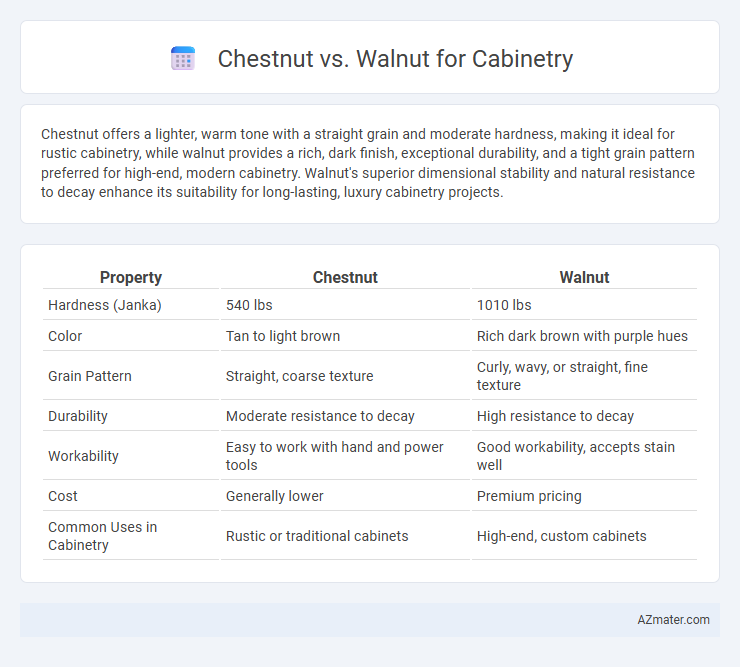Chestnut offers a lighter, warm tone with a straight grain and moderate hardness, making it ideal for rustic cabinetry, while walnut provides a rich, dark finish, exceptional durability, and a tight grain pattern preferred for high-end, modern cabinetry. Walnut's superior dimensional stability and natural resistance to decay enhance its suitability for long-lasting, luxury cabinetry projects.
Table of Comparison
| Property | Chestnut | Walnut |
|---|---|---|
| Hardness (Janka) | 540 lbs | 1010 lbs |
| Color | Tan to light brown | Rich dark brown with purple hues |
| Grain Pattern | Straight, coarse texture | Curly, wavy, or straight, fine texture |
| Durability | Moderate resistance to decay | High resistance to decay |
| Workability | Easy to work with hand and power tools | Good workability, accepts stain well |
| Cost | Generally lower | Premium pricing |
| Common Uses in Cabinetry | Rustic or traditional cabinets | High-end, custom cabinets |
Chestnut vs Walnut for Cabinetry: An Overview
Chestnut and walnut are popular hardwood choices for cabinetry, each offering distinct aesthetic and functional qualities. Chestnut features a light to medium brown tone with prominent grain patterns, providing a warm, rustic appearance ideal for traditional or farmhouse-style cabinets. Walnut, known for its rich, dark brown color and smooth texture, delivers a sleek, modern look with superior strength and durability, making it a preferred option for high-end cabinetry.
Appearance and Grain Patterns Compared
Chestnut cabinetry showcases a warm, golden-brown hue with a straight, coarse grain pattern that offers a rustic and inviting appeal. Walnut features a rich, deep chocolate to purplish-brown color with a fine to medium grain exhibiting intricate swirls and waves, adding luxurious depth and elegance. The distinct grain patterns of walnut create a more dramatic and sophisticated look, while chestnut's uniform texture provides a natural, traditional charm in cabinetry design.
Durability and Strength: Chestnut vs Walnut
Chestnut and walnut both offer notable durability for cabinetry, but walnut ranks higher in strength due to its tighter grain and denser composition, making it more resistant to dents and scratches. Chestnut, while durable, is softer and more prone to wear over time, which may affect longevity in high-traffic areas. Walnut's superior hardness, approximately 1,010 on the Janka scale compared to chestnut's 540, ensures enhanced structural integrity and lasting performance in cabinetry applications.
Workability and Ease of Finishing
Chestnut offers superior workability due to its medium density and straight grain, making it easier to cut, shape, and sand compared to walnut. Walnut, while denser and harder, provides a smooth finish but may require more effort and sharper tools during machining. Both woods take finishes well, yet chestnut's open grain absorbs stains more evenly, facilitating a consistent final appearance.
Cost Differences Between Chestnut and Walnut
Chestnut cabinetry generally costs less than walnut due to the lower market price and greater availability of chestnut lumber. Walnut's rich color, tight grain, and durability make it a premium wood, resulting in higher costs for both raw material and finished cabinets. Buyers often choose chestnut for budget-friendly projects while walnut suits high-end cabinetry with long-term value.
Sustainability and Availability
Chestnut cabinetry offers a sustainable choice due to its fast growth rate and widespread availability in North America, enabling responsible harvesting and reduced environmental impact. Walnut, while prized for its rich color and durability, grows more slowly and is less abundant, which can lead to higher costs and potential sustainability concerns. Choosing chestnut supports eco-friendly practices through its regenerative qualities and easier sourcing compared to the more limited supply of walnut wood.
Maintenance and Longevity
Chestnut cabinetry requires moderate maintenance due to its softer grain, which is more prone to dents and scratches, and benefits from regular sealing to protect against moisture damage. Walnut, known for its dense hardwood and natural resistance to wear, offers superior longevity with minimal upkeep, maintaining its rich color and smooth finish over time when treated with periodic oiling or waxing. Both woods age beautifully, but walnut typically outlasts chestnut in high-traffic kitchen environments due to its robust durability and lower susceptibility to damage.
Design Versatility and Style Impact
Chestnut offers a warm, reddish-brown hue with a fine, straight grain that complements both traditional and modern cabinetry designs, adding a subtle elegance and timeless appeal. Walnut features a rich, dark brown color with complex grain patterns, providing a bold, luxurious statement ideal for high-end and contemporary kitchens. Both woods enhance style impact, but chestnut's lighter tone offers greater versatility across various interior styles, while walnut emphasizes sophistication and depth.
Best Uses in Cabinetry Applications
Chestnut wood offers a warm, rustic aesthetic with good durability, making it ideal for traditional cabinetry and furniture that requires a natural, textured appearance. Walnut is prized for its rich, dark color and smooth grain, suited for high-end cabinetry where elegance and fine finish are prioritized. Walnut's hardness and resistance to wear make it preferable for kitchen cabinets and high-traffic areas, while chestnut works well in decorative panels and less demanding cabinetry applications.
Making the Right Choice: Chestnut or Walnut?
Chestnut offers a warm, rustic appearance with a lighter, golden-brown tone and noticeable grain patterns, making it ideal for traditional or country-style cabinetry. Walnut features a rich, dark chocolate hue with smooth, fine grains, providing a sleek, modern look and superior durability for high-end kitchen cabinets. Choosing between chestnut and walnut depends on desired aesthetics, budget considerations, and the cabinet's intended durability and style impact.

Infographic: Chestnut vs Walnut for Cabinetry
 azmater.com
azmater.com